Mastering Wakesurfing: Tips for Getting Up on the Board
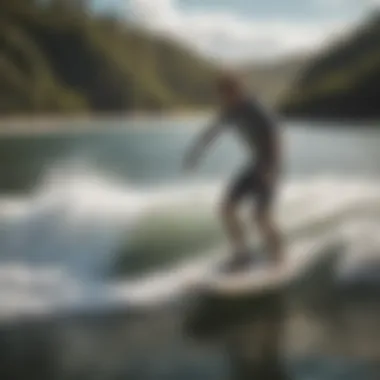
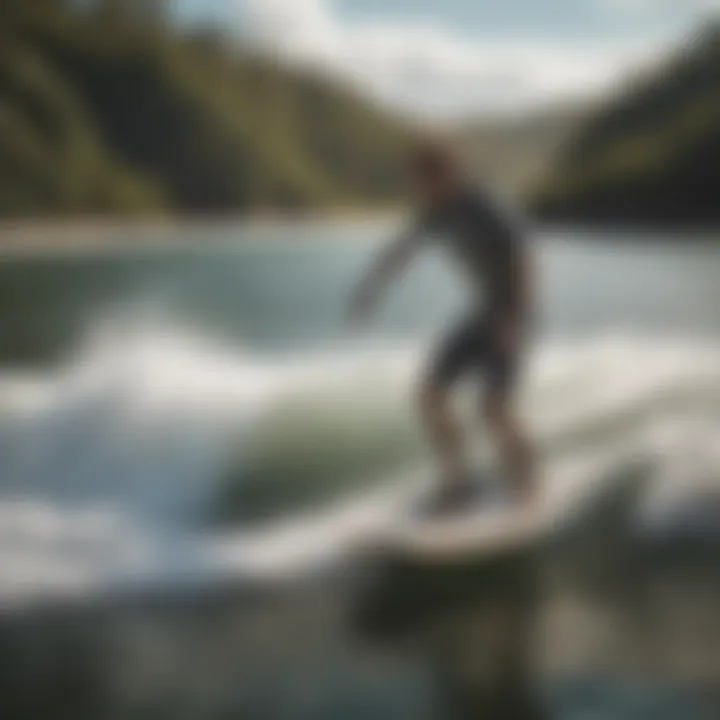
Intro
Wakesurfing offers an exhilarating experience that combines the thrill of surfing with the excitement of being towed behind a boat. Mastering the basics can be tricky, especially when trying to get up on the wakesurf board for the first time. This guide aims to provide clear directions, key insights, and effective techniques that will help you rise from the water and enjoy this fantastic sport.
Understanding the nuances of body positioning, the mechanics of the boat, and the unique dynamics at play are all crucial components in successfully getting up on a wakesurf board. You need not be an expert to start; with the right guidance and practice, anyone can learn to catch those tasty wakes.
Surfboard Reviews
When choosing a wakesurf board, it certainly pays off to know the different types available. The right board can make all the difference, especially for beginners.
Types of Surfboards: An Overview
Wakesurf boards generally come in three main types:
- Skim Style Boards: These boards are typically shorter and offer a lightweight design, making them great for tricks and nimble movements. They're perfect for those who love to play around on the water.
- Surf Style Boards: These boards are longer and have a more noticeable rocker. They provide stability and are favored by many for a smooth ride over the wake. Perfect for novices who are learning the ropes.
- Hybrid Boards: As the name suggests, hybrid boards combine elements of both skim and surf styles. They allow for both surfing and trick riding, appealing to a wider range of riders.
Best Surfboards for Beginners and Pros
If you're just starting, opting for a surf style board is wise due to its forgiving nature. Suggested boards like the Liquid Force Fish Wakesurf Board or the Heyday Wakesurf Board offer reliable control and stability, ideal for learners.
For seasoned surfers, a board like the Ronix Koal Surface Wakesurf Board delivers versatility and performance on the waves, letting you push your skill set further.
Surfing Techniques
With the right board in hand, let’s dive into crucial techniques that will help you get up and riding.
Essential Techniques for Beginners
Getting up on a wakesurf board revolves around understanding how to use the boat’s pull effectively. Here are some pivotal steps:
- Start in the Right Position: Begin by sitting in the water with your knees drawn to your chest and your arms grasping the handle. Ensure the board’s nose points upwards slightly.
- Leverage the Boat’s Pull: As the boat accelerates, resist the urge to stand up immediately. Instead, let the boat’s power do the work. As the rope tightens, slowly stand up like you’re getting out of a chair.
- Find Your Stance: Your feet should be shoulder-width apart. Keep your weight centered over the board, and bend your knees slightly. Look ahead, not down.
- Shift Your Weight: If you feel unsteady, shift your weight slightly to your back foot for balance. This will help you maintain control and avoid any unwanted slips.
Advanced Maneuvers for Experienced Surfers
Once you're up and riding, you might want to try some advanced techniques to impress your friends:
- Cross-stepping: This technique involves walking from the tail to the nose of the board, creating a stylish ride.
- 360 Spins: By shifting your weight and using the boat's pull, you can spin the board in a full circle. It takes practice but is definitely a crowd-pleaser!
- Riding Switch: This means transitioning to riding on your opposite foot forward. It improves balance and overall skill.
Understanding Wakesurfing
Understanding wakesurfing is foundational for anyone looking to navigate this exhilarating sport. Wakesurfing isn't just a hobby; it encompasses a unique blend of skill, balance, and a deep appreciation for the dynamics of water. As such, it’s not simply about riding a board but mastering how to harness the boat’s wake in a way that enhances your ride. Recognizing its nuances and mechanics is critical to making the most of your time on the water.
Definition and Concept
Wakesurfing entails riding a board similar to a surfboard but specialized for being pulled by a boat at a slower speed, typically between 10 to 15 mph. Upon being towed, the rider begins in a prone position on the board and, through various techniques, transitions to a standing position and rides the wake created by the boat. The beauty lies in the thrill of riding the wake without being attached to the tow rope after getting up. Essentially, you are surfing your own wave.
The concept revolves around using the boat's wake to create a moving wave, allowing the wakesurfer to glide with minimal effort. Mastering this balance fosters a direct connection with the water, making the experience feel almost meditative.
Wakesurfing vs. Wakeboarding
While wakesurfing and wakeboarding may seem like two peas in a pod, they are quite distinct activities, each offering its unique set of challenges and thrills.
- Equipment Differences:
- Riding Style:
- Speed and Technique:
- Wakesurf Board: Generally shorter, wider, and more buoyant. Designed for surf-like maneuvers, these boards offer a different experience compared to traditional wakeboards.
- Wakeboard: Longer and typically fitted with bindings, allowing a more aggressive ride.
- In wakesurfing, the rider tends to use a more relaxed stance, allowing for smoother, more fluid motions on the water. The absence of bindings enables a freer experience, letting the rider shift weight and maneuver effortlessly.
- In contrast, wakeboarding often requires a more rigid stance since the board is attached to the feet, promoting jumps and tricks off the wake, which involves higher speeds and intense control.
- Wakesurfing usually takes place at lower speeds, allowing riders to feel the pulse of the water. The focus here is on balance and wave navigation.
- Wakeboarding relies on higher speeds and involves more abrupt movements and jumps, leading to a different learning curve.
Understanding these differences is crucial for beginners, ensuring that one chooses the correct path suited to their goals and preferences on the water.
"Wakesurfing is not just about the sport; it's about reading the water and becoming one with it."
By comprehending the essence of wakesurfing, riders can lay the groundwork for a successful and enjoyable experience on the water. The knowledge encapsulated in the definitions and distinctions paves the way for deeper engagement as one prepares to get up on their wakesurf board.
Required Equipment
When you're setting out to conquer the wakesurfing waters, having the right gear makes all the difference. Sure, you might see some folks playing around on borrowed boards, but if you’re serious about making a splash and enjoying your time on the water, you’ll want to invest in the proper equipment. Not only does it enhance your experience, but it also provides safety and comfort while you’re out there, mastering those tricks and turns.
Choosing the Right Board
The board is your primary tool for wakesurfing. Like a canvas for an artist, the right board can make or break your performance. When you’re choosing one, consider factors like your experience level, weight, and riding style. If you’re just dipping your toes into the wakesurfing pool, a wider board with a larger surface area will offer you more stability and easy balance.
On the flip side, if you have a bit of experience and want more maneuverability, you might want a shorter board.
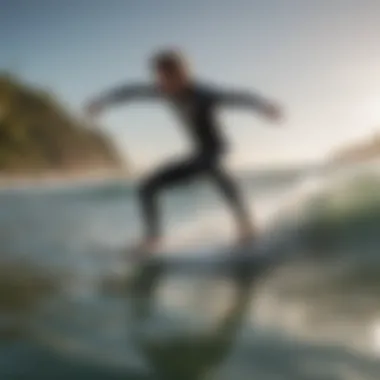
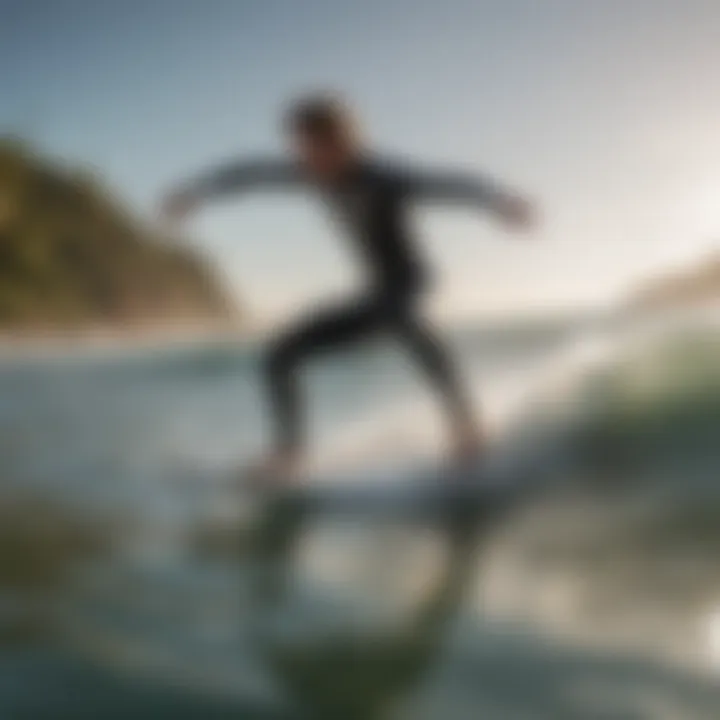
Some points to think about include:
- Types of boards: Look for either a foam-surf or skim-style board. The former offers a buoyant ride while the latter is lighter and versatile.
- Length and width: Longer boards glide better while wider boards are easier for beginners.
- Rocker: A board with more rocker provides better control when turning. Too much can slow you down, though.
Finding a board that fits your body and skill level is key to blurring the lines between falling and flying on your wakesurf board.
Wakesurf Cable and Boat Setup
Now let’s talk about the vessel that will pull you into fun. A carefully set up boat can help you create the ideal wake. Most wakesurfing is done behind a specially modified boat, which generates a swell that you can ride.
For optimal performance, a few practical considerations include:
- Weight Distribution: This directly affects the size of the wake. Balancing the weight properly can make a big difference. Consider adding ballast bags or bringing along friends for added weight towards the rear—this will enhance your wake's shape. Preferably, aim for a somewhat heavier rear setup for a better launch.
- Speed: Aim for speeds of around 10 to 12 mph. Too slow, and you’ll struggle; too fast, and you risk being thrown off balance.
- Wakesurf Cable: Using a wakesurf-specific rope can also help keep a consistent distance from the boat. It provides better control and enables you to focus on refining your technique.
By tweaking your boat setup and ensuring you have the right cable, you can craft a wake that feels like a magic carpet ride.
Safety Gear Considerations
Safety can't be an afterthought when you're up on that board. No one wants to take an unintended plunge under the water's surface. Here are some essentials:
- Life Jacket: Wearing a properly fitted life vest is crucial, especially for beginners. It provides buoyancy and keeps you safe in case things go sideways.
- Wetsuit: Depending on the temperature of the water, a wetsuit can keep you warm and protect from scrapes or sunburns. Plus, it feels good to have that extra layer when you fall.
- Helmet: It may seem unnecessary to some, but a helmet can really save your noggin from impact when learning new tricks. Falling, especially when learning, can be unpredictible and requires all the protection you can get.
Remember, it’s always better to be over-prepared than underprepared when having fun in the water. Gearing up with the right equipment not only ensures a better wake-surfing experience but also adds a layer of reassurance.
Ultimately, the equipment you select can have an enormous impact on your learning curve and the enjoyment you derive from wakesurfing. Each piece plays a role in not just performance, but safety too—setting the stage for countless waves of fun.
Initial Steps Before Getting Up
Before you even think about riding the waves, there’s a good bit to do before getting up on a wakesurf board. These initial steps are crucial because they lay the groundwork for your entire wakesurfing experience. Think of it as preparing to bake a cake; if you don't gather the right ingredients and tools, your cake might just flop. In wakesurfing, taking the time to understand the board and its nuances can turn what seems like a daunting task into a more manageable and enjoyable endeavor.
Going through these steps not only builds your confidence but also makes the actual process of getting up smoother. Understanding the board intimately allows you to react better once you're in the water. Plus, it helps save you from some common rookie mistakes that can lead to frustration or even injuries. The aims here are clarity and comfort before hitting the water.
Familiarizing with the Board
Getting comfortable with your wakesurf board is step number one. Hold it in your hands, feel the edges, and examine its length and width. It’s more than just a piece of equipment; it’s your new best friend on the water! Knowing the different parts of the board, from the tail to the nose, can help you understand how it will react under your feet as you start to ride.
Key aspects to focus on include:
- Weight and Size: Boards come in various sizes, and how you fit on the board can greatly affect your balance and performance.
- Rocker Profile: Check if your board is flat or has a curve. This will influence how it behaves in the water. Flat boards tend to be faster, while curved ones help with maneuverability.
- Tail Shape: Different shapes impact how the board cuts through the water. Understanding this can aid greatly when making turns or doing tricks.
Once you’ve gotten a feel for the board, standing on it while it’s on stable ground is a great exercise. This position will train your muscle memory for when you’re in the water. Try standing still first, then shift your weight from one foot to the other, just like you'll have to do once you're up.
Understanding Weight Distribution
Weight distribution can make or break your performance on a wakesurf board, and it's pivotal in maintaining that balance you need when you’re up. It’s not just about where your feet go; it’s also a matter of how you leverage your body to keep upright.
When you start wakesurfing, it’s essential to center your weight over the board. This notion may sound simple, but too many newcomers tend to lean forward or backward or shift their weight unevenly, which causes them to tumble.
Here’s a checklist to help you get the hang of it:
- Feet Positioning: Keep your feet shoulder-width apart on the board. That’s the sweet spot for balance.
- Knees Bent: By bending your knees slightly, you'll absorb the board’s movements, helping you stay stable.
- Upper Body Relaxed: Tension in your shoulders can throw you off balance. Keep them relaxed and face forward.
- Looking Ahead: Always look in the direction you want to move. Your body will naturally follow your gaze, which helps with steering.
- Shifting Weight: Once you’re up, you can shift your weight slightly to the back to gain speed, or lean forward to slow down.
Understanding your weight distribution not only makes getting up easier but turns your attempts into a safe and thrilling experience, where you can fully enjoy the wave rather than battling it.
"Mastering the fundamentals of balance and body positioning is the cornerstone of wakesurfing success. The more aware you are of your body’s relationship to the board and the water, the less you’ll struggle to find that sweet spot."
By taking these initial steps, you're not just getting ready to ride; you're setting yourself up for a satisfying and less stressful adventure on the water. With all this under your belt, you’ll be well-equipped to tackle the next phase: positioning yourself on the board.
Positioning Yourself on the Board
Positioning yourself effectively on a wakesurf board is crucial. It can determine not only how quickly you get up but also how well you maintain balance while riding. Getting the positioning right can take time, but with practice, it becomes second nature.
Your body’s placement influences your center of gravity. A low center of gravity tends to enhance stability since it lowers the risk of losing balance. Think of it like riding a bicycle; the more you lean into your turn, the easier it is to keep control. When surfing, your weight distribution aids in navigating the wakes created by the boat.
- Benefits of Proper Positioning:
Initiates smoother rides.
- Enhances your confidence while on the water.
- Reduces the chance of fallings, which can be disheartening for beginners.
Maintaining the right stance can make the difference between gliding smoothly or tumbling into the water. As with any sport, finding what feels natural for you can help you adapt over time.
Ideal Stances and Balance Techniques
Selecting the right stance is like finding your rhythm in music. The key is to balance comfort with control. Feet shoulder-width apart typically provide the best base. You want your knees slightly bent, ready to absorb the wakes as they come.
Some riders prefer a narrower stance, while others like to keep their feet wider apart. There’s no one-size-fits-all approach—experiment to see what suits you best.
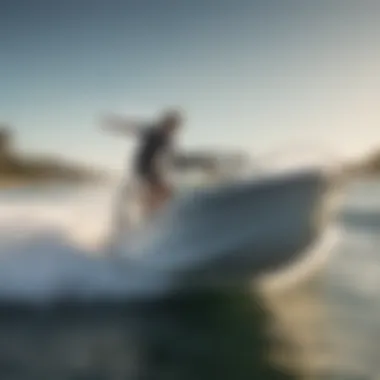
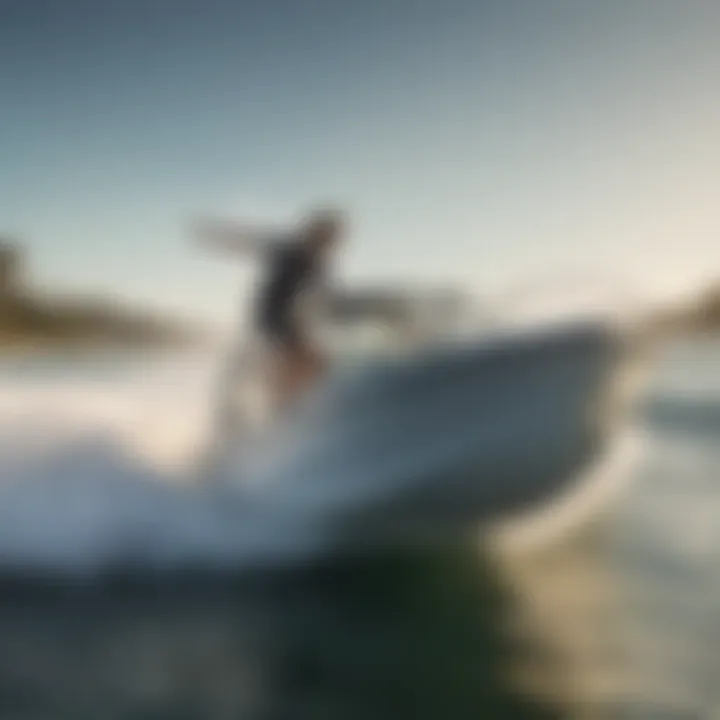
A common technique involves leaning slightly forward, which can help you connect more effectively with the waves. Remember to keep your shoulders aligned with your hips; this alignment will improve not just your balance but also your overall maneuverability.
A simple drill to test your balance is to practice standing on land. With your knees bent, try to shift your weight from one foot to the other. This exercise could help familiarize yourself with the necessary movements.
Foot Placement Guidelines
Getting foot placement right is essential to your success in wakesurfing. Your back foot should rest near the tail of the board, while the front foot sits closer to the center. This distribution allows for agile adjustments while riding. Below are a few tips:
- Back Foot:
- Front Foot:
- Position it as far back as possible for maximum control.
- Experiment with angles; some prefer it angled outwards while others find it better straight.
- Keep it more centered for stability.
- Ensure your toes point a bit towards the nose of the board.
Having each foot in a proper position aids in preventing any uncomfortable movements when you’re trying to stand. Finding the sweet spot will require practice; don’t be discouraged if it takes a few tries to solidify your technique.
Remember: Your foot placements significantly influence your ability to catch the perfect wave. Pay attention to details, and adjust as needed.
The Art of Getting Up
Getting up on a wakesurf board can often feel like trying to dance on water while the music's still being set up. The art of getting up holds a significant place in the learning journey of any aspiring wakesurfer. It’s not just about the technical aspects; it helps instill a sense of rhythm and balance that can elevate your overall experience out on the water. Having proper timing and coordination with the boat can mean the difference between a graceful rise and a not-so-friendly splash. Plus, understanding gradual movements to stand helps minimize accidents and maximizes enjoyment.
This section aims to break down the essential elements of mastering the art of getting up, turning the intimidating start into a smooth and engaging process. It's a cornerstone in the adventure of wakesurfing that sets the stage for future tricks and maneuvers.
Timing and Coordination with the Boat
The relationship between you and the boat is akin to a finely tuned dance. When you start, timing is absolutely crucial. The boat is moving, creating a wave behind it, and your goal is to match its rhythm with your movements. The timing of when you begin to pull yourself up must align perfectly with the boat's acceleration. If you go too early, you risk face-planting into the water; too late, and you might miss the wave altogether.
A good practice to consider is to have someone onboard call out the signal for when to start. Something simple like "Go!" can help create that synergistic flow. This coordination will not only help you get up effectively but will also build your confidence on the board.
"Timing is everything. In surf, just like life, harmony in movement opens doors to mastery."
Gradual Movements to Stand Up
Once you’re in the right position, it’s all about slow and steady. Instead of trying to pull yourself up all at once, think about it in stages. Start by bending your knees while keeping your board steady in the water. Once you feel the boat begin to pull you, maintain a low center of gravity. Gradually shift your weight forward, and as you gain stability, push your hips up and move into a standing position.
Remember to keep your arms relaxed and use them for balance, rather than yanking yourself upright. If you rush the process, the chances of losing balance increase significantly.
Here’s a quick tip for practice:
- Start with your knees bent: It lowers your center of gravity.
- Engage your core: It helps in maintaining balance.
- Shift your weight slowly: Think of it like a seesaw.
With practice, these movements will become second nature. Getting up can sometimes feel daunting, but once you've grasped the art of timing and gradual movements, you'll find the experience rewarding. Whether navigating through wakesurfing techniques or seeking other tricks, mastering these basics becomes your stepping stone to greater achievements on the water.
Common Challenges and Solutions
When it comes to wakesurfing, the thrill is often accompanied by a meteor shower of obstacles, especially for those just beginning their journey on the water. Understanding the common challenges faced by novices not only helps in overcoming them but also fosters a deeper appreciation for the sport. Everyone grapples with some bumps in the road—and how you tackle these hurdles can make all the difference between frustration and exhilaration.
Struggles with Balance
Balance is the name of the game in wakesurfing. For many newcomers, the first moments on the board feel like a circus act. A little wobble here, a little shift there, and you're in the drink. Achieving that elusive equilibrium requires familiarity with the board and an understanding of your body's mechanics.
- Posture Adjustment: A common mistake is not keeping a straight back. Bend your knees slightly, lean forward, and keep your body centered over the board. Your core is your best friend here—it provides stability and control.
- Practice Paddling: Before you even try to stand up, practice paddling on the board in the water. This can feel awkward at first, but it helps your body adjust to maintaining balance while buoyant. It's all about knowing how your body moves with the board.
- Mind Over Matter: Don’t let the thought of falling overwhelm you. This sport is as mental as it is physical. Focus on finding your footing rather than worrying about losing it. A calm mind often leads to a more stable ride.
- Use the Boat’s Wake: Understanding the wake's dynamics is crucial. Ride along the seam of the wake with slightly bent knees. It provides a natural point of balance when you lean back slightly.
"Balance is not just about standing still; it's about understanding your body's weight distribution over the board."
Difficulty in Getting Up
So, you've found the sweet spot in balancing, but the next mountain to climb is the art of actually getting up on the board. This step can feel monumental for many. Here’s a look at some key considerations to help you rise from the water to the waves.
- Timing With the Boat: As the boat takes off, it can be deceptively strong—if you pull up too soon or too late, you may end up with a quick splashdown. Syncing your movements with the acceleration is essential; a gradual pull upward as the boat builds speed is key.
- Gradual Movements: Instead of making one jerk motion to stand, think about it like unfolding a piece of paper. Start with your knees bent, then gently push through your legs. It’s all about smooth, deliberate actions.
- Handle Positioning: Keep the rope at hip height. If it’s too high or too low, it could throw off your balance. Hold the rope firmly yet relaxed in your hands. Your grip can influence your body’s center of gravity.
- Experiment and Adapt: Each wakesurfer has a unique rhythm and style. Don’t shy away from experimenting with foot placement and timing. What works for a friend might feel uncomfortable for you. Test the waters and find your groove.
- Above All, Patience is a Virtue: Remember that even the greats started at the same point you are now. Falling is part of the learning curve. Embrace each setback as a stepping stone to mastering the art of rising up.
By acknowledging these common pitfalls and arming yourself with practical solutions, you can transform challenges into productive practice sessions. The keystones of balance and getting up on the board are crucial for progressing in wakesurfing. Over time, with dedication and practice, you’ll find yourself gliding on the waves, feeling the thrill that comes with mastering your craft.
Tips for Improving Your Technique
Improving your technique in wakesurfing can make all the difference between a thrilling ride and a tough struggle. Mastery over your moves not only enhances your enjoyment but also boosts your confidence on the water. Fine-tuning your skills means paying close attention to your body mechanics, understanding how the board reacts, and getting comfy in the wake. Let’s break down some practical approaches you can implement to elevate your wakesurfing game.
Practicing with a Spotter
Having a spotter is one of the best ways to sharpen your wakesurfing skills. A spotter acts as your eyes and ears, providing real-time feedback that you might miss while you’re focused on balancing on the board. It's not just about safety; it’s about learning. Your spotter can help you identify what to tweak—maybe your stance is too wide or your weight is not evenly distributed.
- Communication is Key: Make sure you’re on the same page about what you aim to improve. Do you want to work on your paddle technique, or are you trying to stick a new trick? Your spotter should be aware of your goals.
- Feedback Loop: After your ride, discuss what went well and what could use some work. Maybe you're leaning too far back, causing the nose of the board to dive, or perhaps your knees are not bent enough for stability.
Working together creates an environment where mistakes become a part of the learning process. It’s less intimidating when someone’s there to guide you—kind of like having training wheels while you find your balance.
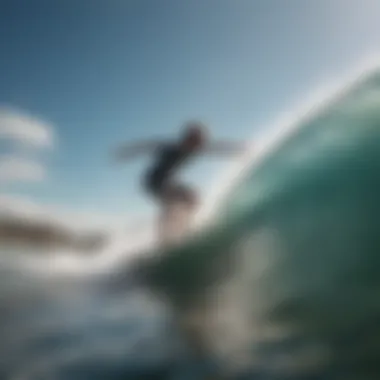
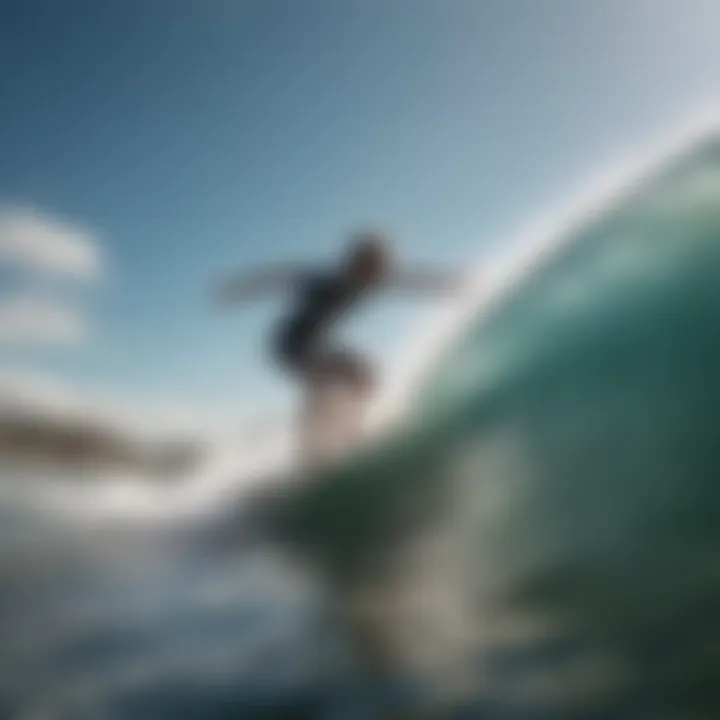
Utilizing Video Analysis
In this digital age, video analysis can serve as an invaluable tool in your wakesurfing training. Recording your session allows for reflection and in-depth review. Let’s face it, sometimes you think you’re doing everything right, but that video tells a different story.
- Capture Different Angles: Make sure to film from various positions—side, front, and even behind the boat. Each perspective reveals different insights about your form and technique.
- Slow It Down: Play the footage at a slower speed to spot the subtleties in your movements. This can highlight areas where you may be tense, which impacts your ability to ride smoothly.
- Track Your Progress: Save videos from each session and note the improvements over time. This will motivate you and remind you of past achievements, even if they're just small tweaks to your form.
Using this kind of analysis gives a clearer picture of how you can adapt your approach for better results, as well as honing in on specific areas that need attention.
"Good technique is the foundation of a successful ride; never underestimate the power of practice and precise feedback!"
By approaching your wakesurfing with a mindset geared towards improvement—whether it’s through having a supportive spotter or harnessing the tech at hand—you steer yourself toward becoming a more capable and confident surfer. Take the time to refine these techniques, and you may find yourself pulling off tricks you once thought were beyond your reach.
Transitioning Between Tricks
Understanding how to transition between tricks is imperative for anyone looking to elevate their wakesurfing experience. Much like a dance, these transitions allow a surfer to maintain momentum while showcasing their individual style. They blend fluidity with control, creating a seamless experience on the water. This práctica not only enhances your performance but also builds confidence as you progress in your skill set.
Getting Comfortable on the Board
Before you can start weaving in and out of more complex moves, it’s essential to feel at home on your board. This means establishing a solid foundation. Comfortable positioning means different things for different people, but here are some key points to keep in mind:
- Practice Regularly: Familiarize yourself with the board and spend time riding it in calm waters to adjust to the buoyancy and stability.
- Foot Placement: Ensure your feet are lined up correctly; position them where you feel the most balanced. Think of it as the sweet spot.
- Relaxation is Key: Tension in your body can lead to miscalculations and falls. Stay relaxed to improve your balance. Envision a tall tree that sways gently in the breeze, instead of a stiff pole.
As you gain familiarity and comfort, try small transitions between tricks. For instance, practicing basic shifts from riding switches to regular stance can enhance your adaptability on the board. The more at ease you are, the easier it will be to integrate new tricks bit by bit.
Exploring Advanced Moves
Diving into advanced moves offers a thrilling challenge and can put the cherry on top of your wakesurfing skills. Advanced tricks, whether sourced from freestyle or aerial categories, often rely heavily on the transitions you’ve practiced. When attempting these maneuvers, consider:
- Understanding Dynamics: Leverage the boat’s wake to your advantage. It’s all about timing and harnessing the wave as you shift into trick execution.
- Incremental Progression: Don’t bite off more than you can chew. Start with simpler variations of complex tricks, and gradually work up to their full forms.
- Watch and Learn: Observing others or watching yourself on video can help you identify areas for improvement. The nuances of body movement often reveal themselves in replay.
Whether it's progressing to a 360 spin or launching into an aerial maneuver, each step is a building block toward greater mastery. Every accomplished trick opens doors to more complex feats.
"Success in wakesurfing isn’t solely defined by what you can do; it’s also about how you can transition from one move to another, melding them into a singular dance."
As you refine your skills in both comfort and trick executions, you open yourself up to endless possibilities on the water. Remember, the journey is as important as the destination, and each attempt brings you closer to becoming a savvy wakesurfer.
Safety and Etiquette on the Water
Safety and etiquette on the water are crucial components for any wakesurfer's experience. A blend of proper safety measures and an understanding of the unwritten rules of the water can make the difference between a fantastic day of surfing and a hazardous situation. Getting familiar with these elements not only ensures your safety but also contributes to a smooth sailing experience for everyone involved.
Understanding Waterway Regulations
Waterway regulations serve as the backbone of safe wakesurfing. Each location can have its own set of rules, which often vary depending on local ordinances, environmental considerations, and community guidelines. Knowing these rules can help avert unnecessary accidents and potential fines.
- Buoyancy Alerts: Be aware of designated zones where wakesurfing is permitted or strictly prohibited. Many jurisdictions enforce no-wake zones around certain areas like marinas or swimming zones.
- Speed Limits: Different waterways may impose speed limits to ensure safety for everyone. Adhering to these limits not only shows respect for other water users but also helps in preventing collisons.
- Licensing Requirements: Some places necessitate a boating license or a special permit for wakesurfing. Be sure to research what is required in your locality before hitting the waves.
Understanding these regulations is not just a matter of compliance; it’s about keeping the fun in wakesurfing alive while minimizing risk. Another big consideration is environmental protection. Respecting local wildlife and natural habitats is imperative, and keeping your distance from nests or feeding areas showcases your commitment to preserving the environment.
Respecting Other Water Users
Remember, the water is a community space. When wakesurfing, you'll find yourself sharing the waves with boaters, swimmers, paddleboarders, and fishermen. Respecting these other users not only fosters a cooperative atmosphere but also enhances the overall experience for everybody.
- Maintain Distance: Try to keep a safe distance from other water users. This requires some situational awareness on your part. If you see someone swimming or fishing, it’s prudent to steer clear; nobody wants to deal with a boat puttering by too close.
- Minding Your Wake: Wakesurfing creates larger waves, which can affect other boaters or swimmers. Consider the impact of your wake and attempt to manage it accordingly, especially when in crowded areas.
- Polite Signals: Utilize hand signals or vocal cues to alert others of your intentions. This goes a long way in preventing accidents and avoids miscommunications.
"A safe surfer is a happy surfer. When respect rolls out, fun rolls in."
Having the mind set to respect the shared nature of the water will make it easier for you to have a positive experience while also promoting a sense of community among all water enthusiasts. In summary, following the established regulations and respecting the presence of other users is as important as mastering your surfing technique. Your skill on the board can shine even more brilliantly in an atmosphere built on mutual respect and safety.
Culmination: A Path to Progress
In the world of wakesurfing, the journey is as rewarding as the destination. When it comes to mastering the art of getting up on a wakesurf board, conclusion carries weight. It’s not only about landing those perfect rides but also about acknowledging the growth one undergoes throughout the process.
As you paddle your way through the early stages of learning, the essentials outlined in this article become touchstones for progress. Every attempt, every stumble, and every small victory leads to deeper understanding of the mechanics at play. The endeavor of getting up is a reflection of one’s determination and spirit on the water.
Reflecting on Growth
Reflecting on growth involves taking a step back and honestly assessing the strides taken as a wakesurfer. Each time you find yourself getting up, balancing, and carving through the wake, think of the obstacles you’ve tackled. Whether it was the uneasy feeling of falling in the water repeatedly, or managing your weight distribution just right to find that sweet spot, these experiences shape you into a more proficient rider.
Understanding where you began and how far you've come is crucial. Here are a few considerations when reflecting on growth:
- Track Your Progress: Keeping a journal about your experiences can be enlightening. Jot down what works and what doesn’t. You may notice patterns that can be adjusted in subsequent efforts.
- Celebrate Small Wins: Each time you manage to get up, however brief your ride is, recognize that as a step forward.
- Community Feedback: Engaging with fellow surfers can provide insights from different perspectives, be it through conversations or video analyses shared online.
Setting Future Goals
With the foundational skills established and your progress noted, the next step is charting your path forward. Setting future goals isn’t just a matter of wanting to land a specific trick or ride longer distances; it’s about envisioning your journey in broader terms.
Begin with realistic goals and gradually work your way up to more advanced challenges. Consider the following:
- Short-term Goals: These might include perfecting your stance or increasing the duration of your rides. Establish achievable targets that keep you motivated.
- Long-term Goals: Once you feel confident with the basics, aim for more complex maneuvers like 180s or controlled slides.
- Skill Diversification: Think about incorporating other water activities into your routine, such as learning to wakeboard or even surf in ocean waves. This not only boosts your overall skills but keeps the fun alive.
"In wakesurfing, every moment on the water is a chance to learn something new about yourself and the sport. Keep pushing your limits."
As you ride the waves, remember that the path to progress is not a sprint but a winding road filled with turns, jumps, and unexpected stops. Your adventure in wakesurfing is a continual learning experience, where every time you get back on the board, you have the opportunity to grow and evolve as a surfer.















